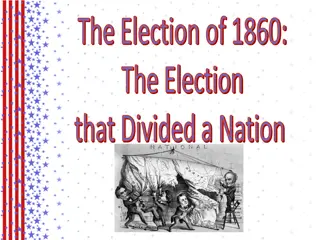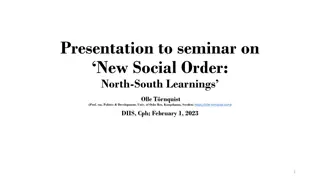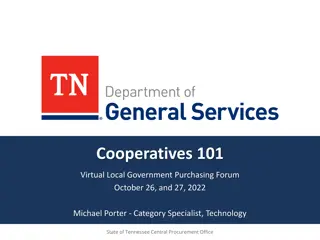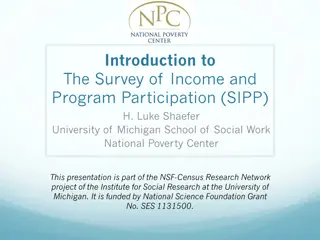Cooperative Ownership and Democratic Participation in Economic Models
Explore the principles of cooperative ownership, democratic participation, and economic models as advocated by Jessica Gordon-Nembhard. She emphasizes the historical significance of collective work, indigenous cooperative efforts, and the values of shared risk and surplus sharing in community-owned enterprises. The concept of one member, one vote and the diversified ownership structures across various sectors of society are central themes in promoting a more inclusive and sustainable economy.
- Cooperative Ownership
- Democratic Participation
- Economic Models
- Community-Owned Enterprises
- Shared Risk
Download Presentation

Please find below an Image/Link to download the presentation.
The content on the website is provided AS IS for your information and personal use only. It may not be sold, licensed, or shared on other websites without obtaining consent from the author. Download presentation by click this link. If you encounter any issues during the download, it is possible that the publisher has removed the file from their server.
E N D
Presentation Transcript
Jessica Gordon Nembhard, Ph.D. John Jay College, CUNY jgordonnembhard@gmail.com March 30, 2019 BEDC Bermuda
The original occupants/stewards of the land. Acknowledge our ancestors, the struggles of enslaved laborers, & all those who labor without just compensation; and our claim to land and resources. Stand on shoulders of those who use cooperative ownership in the struggle for liberation. Jessica Gordon-Nembhard 2019
Utilized by all populations, in every era, on every continent, pre and post 1844. Notions of the common good, the commonwealth, The Commons, collectivism, collective work and responsibility Indigenous cooperative efforts - First Nations, early African civilizations, etc. Precursors: mutual aid associations, and revolving loan funds/rotating savings & credit/susu. Jessica Gordon-Nembhard 2019
Companies jointly owned by the people in a community who use their services or make the products (member-owners). Created to satisfy a need - formed for a particular purpose to provide a quality good or service at an affordable price (that the market is not adequately providing). Values-based business, double/triple bottom line. governed through democratic economic participation Shared risk and surplus/profit sharing Jessica Gordon-Nembhard 2019
Democratic participation One member, one vote (not by shares owned); directors are members Open participation; open books Limited compensation to capital; for profit or not-for-profit Continuous education Concern for community Cooperation among cooperatives Jessica Gordon-Nembhard 2019
Consumer owned Producer owned Worker owned All sectors of society agriculture, finance, retail, production, arts, health, housing, etc. Jessica Gordon-Nembhard 2019
Cooperatives Investor Stock Corporations Investor/owner 1 share 1 vote Profit motive first Member/owner 1 member 1 vote Satisfy a need; problem solve; accessible and affordable high-quality goods and services Capital subordinate to labor and usage Democratic governance, Democratic participation Solidarity with members and community; Returns to community Capital supreme; capital rents labor Majority and money rule return to investor/owner Jessica Gordon-Nembhard 2019
Survival Resistance Prosperity psupress.org Jessica Gordon-Nembhard 2019
Hundreds of mutual aid societies, Black communal towns, and examples of formal and informal economic cooperation from 1780 to 2013; About 162 legally incorporated cooperative enterprises owned by African Americans in rural & urban areas North & South, from the mid 1800s to the present. plus 20 credit unions and 154 co-ops (listed by Du Bois 1907). Jessica Gordon-Nembhard 2019
Provide quality goods and services Save costs, Increase income and wealth Combat racial discrimination Increase Black economic stability and self sufficiency Save or create decent jobs in their communities Provide independence and self-determination Develops leadership Jessica Gordon-Nembhard 2019
Capitalization and access to capital Adequate and proper orientation and training (cooperative economics and co- op management education) Distrust and excessive competition Ideology Politics and policy Racism and patriarchy Class . Jessica Gordon-Nembhard 2019
Efforts at collective economic action were often thwarted by racial discrimination, white supremacist sabotage and violence, However, efforts persisted throughout the centuries collective courage. Jessica Gordon-Nembhard 2019
Search for alternative economic solutions to address discrimination and inequality. Use African retentions, self-help ideology, and voluntary segregation to create co-ops and racial self-sufficiency Chance to design & manage needed services in culturally, racially & geographically sensitive ways. Jessica Gordon-Nembhard 2019
Cooperative ownership of land opens the door to many opportunities for group development of economic enterprises which develop the total community rather than create monopolies that monopolize the resources of a community. -Fannie Lou Hamer Jessica Gordon-Nembhard 2019
Cooperatives are the best mechanism yet devised to bring about economic democracy. Jessica Gordon-Nembhard 2019
Cooperatives address market failure, underdevelopment and economic isolation and marginality; and increase access to quality affordable goods and services. Are both anti-poverty strategies and community building strategies. Co-ops anchor and stabilize the local economy. Jessica Gordon-Nembhard 2019
Challenges Market Failure Export of Capital < Predatory lending < Unemployment Poor quality education < Housing Crisis Poor nutrition PIC and Re-entry < Worker &Social Co-ops < [Rural Electric, food, etc.] Community Owned Community Development Credit Unions < Worker Co-ops Consumer Co-ops Solutions Co-op Schools; Continuous Education < Housing Co-ops; CUs < Food Co-ops Jessica Gordon-Nembhard 2019
10 Ways that Co-ops Benefit Their Communities Jessica Gordon-Nembhard 2019
Co-ops are institutions of the Solidarity Economy, established to satisfy a need Anchor capital and production in the local community Keep the benefits of and returns to capital & production recirculating among those who produce them, service them, and need them. Jessica Gordon-Nembhard 2019
Co-ops (especially worker) re-circulate resources in a local economy and leverage local resources: Local wages are used in the community and for goods and services that benefit the community. Surplus is returned to members, who live in the community and invest in the community or leverage their local dollars out in the world. Jessica Gordon-Nembhard 2019
Co-ops often buy local - use local suppliers whose activity originates in the community and whose resources also recirculate. Co-ops deliberately direct dollars to the community and support community development ($ donations, in kind contributions of meeting space and supplies, etc., volunteer hours). Jessica Gordon-Nembhard 2019
Established co-op grocery store in 1935(Gary) By 1936 considered the largest grocery business operated by African Americans in U.S. -total sales of $160,000, annual dividends of 2%. Credit union, grocery store, and gas station. Jessica Gordon-Nembhard 2019
BSCP co-ops keep money from decent wages circulating in the Black community Use credit unions to help labor families to save and have access to capital Use consumer stores to sell the items the Black community and keep money in the community. YNCL similar strategy, but larger, national interlocking cooperatives Jessica Gordon-Nembhard 2019
Co-ops promote education and training through: training about how to run a business and read an income and expense statement; industry training; training in meeting facilitation and democratic participation; a well trained board of directors; and public education using orientation brochures, information boards, and product labeling. Jessica Gordon-Nembhard 2019
Many began with study circles. Training is continuous over the member s participation in the cooperative. Skills developed from cooperative ownership are transferable to other economic, political and social situations. Jessica Gordon-Nembhard 2019
Most 20th century co-ops started with a study group - to study economic conditions and cooperative economics. Used mainstream cooperative literature from CLUSA, and emerging Black writings. Black leaders promote study & practice. Jessica Gordon-Nembhard 2019
Started with study group and weekly co-op education meetings for 18 months Night school co-op econ course at local Black High School (Roosevelt)1933; by 1936 the largest academic class enrollment The early members of the study group started a women s guild, reputed to have kept the organization running and invigorated the co-op: Consumers Cooperative Trading co. Reddix: The most important single factor in the co- op s success has been our education program. Jessica Gordon-Nembhard 2019
A. Philip Randolph, and the Ladies Auxiliary of the BSCP promoted cooperatives, especially in Chicago in the 1930s. Spoke about and wrote about co-ops. As early as 1938 the Instructions and Decisions of the Auxiliary included subscribing to journals/newsletters about consumer economics and cooperatives; and studying credit unions and consumer s cooperation. Started several co-ops associated with BSCP. Jessica Gordon-Nembhard 2019
Connections between Black co-ops KC co-op, People s (Chicago), Red Circle to Gary; Red Circle also to DC, Baltimore, Greenbelt. Black local co-op tours connected with Federal Council of Churches conferences and Unitarian Church co-op activities in late 30s. Jessica Gordon-Nembhard 2019
1935 Federal Council of Churches hosted Japanese cooperative leader Kagawa in Harlem, NYC. 1938 study tour of the Antigonish cooperative movement in Nova Scotia (Canada), through Columbia University: 35 whites and 19 Blacks. Jessica Gordon-Nembhard 2019
Two Black schools (Bricks, Tyrrell County) established farmer s cooperatives, credit unions, buyers clubs, health insurance, and a state wide Black cooperative federation in 1930s. North Carolina Council worked with the state agricultural department to develop credit unions and cooperatives. Jessica Gordon-Nembhard 2019
In1936: 3 Black credit unions; By 1948 there were 98 cus, and 48 additional co-op enterprises: 9 consumer stores, 32 machinery co- ops, 4 curb markets, 2 health associations and 1 housing project. Jessica Gordon-Nembhard 2019
Co-ops (especially worker) often lead their industries in providing living wages, and wages higher than industry standards; high quality work with a variety of benefits; and establish democratic control over income and work rules. Jessica Gordon-Nembhard 2019
Co-ops create local jobs and meaningful work; keep jobs in the neighborhood, creating new jobs as the co-op grows, supporting local businesses; value and promote team work; provide job ladder opportunities; and a self management environment. Jessica Gordon-Nembhard 2019
Cooperative Industries of DC was chartered in 1936 as a self-help cooperative in Lincoln Heights, DC. Founded by Sadie Morse Bethel and Nannie Helen Burroughs (president of the National Trade and Professional School for Women and Girls). Jessica Gordon-Nembhard 2019
Co-op of unemployed workers and home-makers - unskilled with annual incomes between $500 - $1000. Began as a producer co-operative for the relief of the unemployed, using a federal government grant to help unemployed women. Over time became a consumer s cooperative & agricultural marketing cooperative. Bought farm in MD. Jessica Gordon-Nembhard 2019
Since 1987 employs unskilled Latina and African American women (often were on public assistance). Leads the industry in above average wages, benefits, career ladder opps, leadership training, and low turnover. Policy advocacy (city and state) to increase Medicare allocations and average wages. Largest worker co-op in US 1700 owners Jessica Gordon-Nembhard 2019
Co-operatives provide economic stability by providing members with a viable community- based business; and environmentally friendly products and services. As residents, co-op members care about the environment and their working conditions. Triple bottom line profit, human & social capital, environmental capital. Jessica Gordon-Nembhard 2019
Develop ecological house cleaning cooperatives in northern CA. Latinas Use natural cleaning prods. Trained in healthy, ecological cleaning & business ownership. Emma s Eco Clean in Oakland Jessica Gordon-Nembhard 2019
South Bronx, NY Incubate worker-owned green businesses rooted in democracy & environmental justice. Provides ecological benefits while doing no harm to workers, surrounding community, or environment. Co-op Academies Jessica Gordon-Nembhard 2019
Co-ops produce affordable and high quality goods and services usually because the market does not provide them healthy food, sustainable energy, non-predatory lending, quality job. Marginalization forced subaltern groups such as African Americans to find alternative economic solutions. Jessica Gordon-Nembhard 2019
In response to marginalization, segregation and discrimination, African Americans practiced economic cooperation and established mutual societies and cooperatives. Free and enslaved Blacks pooled their money to buy their own and their family members freedom. Freedmen established beneficial societies and mutual aid companies to help cover costs of illness and death. Jessica Gordon-Nembhard 2019
More currently African American have used cooperatives when they needed more income, could not find work, and/or needed products that were not being supplied. Freedom Quilting Bee: share cropping insufficient and exploitative, political repression, need control over land and economic independence. Jessica Gordon-Nembhard 2019
Immigrant women have also created cooperatives to help them survive, maintain their own culture, and balance work and family life. Cooperative Economics for Women, WAGES. Jessica Gordon-Nembhard 2019
Exploited populations within and without the criminal justice system. Employers won t hire returnees must legally identify themselves; Incarcerated are used as slave labor in prison, can t support their families. Need new or different skills when return; Newcomers in some way; Bad previous experience(s) Jessica Gordon-Nembhard 2019
The co-ops in prisons and with formerly incarcerated workers in Italy provide values driven work, and good paid jobs so can support their families. Also supports access to mainstream employment, drawing on their network of professional relationships. Co-ops develop a solidarity, cultural and relational environment that generates resources that enable desistance, recovery and integration. Provide support to the families of imprisoned workers and facilitate family mediation; create the space for family contact to occur in more natural and private environments. Jessica Gordon-Nembhard 2019
Began with art therapy Learned about co-op model and demanded co-op education Changed co-op law meeting with Governor Rephrased the 7 principles; internal rules MOU with Corrections Department 15% (office space, electricity, etc); have to pay for extra security 10% retained; 75% to owners Only 2 recidivists of 50 + who got out over 10 years. Jessica Gordon-Nembhard 2019
Pooling scarce resources Leveraging resources Reducing individual risks Profit sharing and a share of the co- op s equity Collective ownership and democratization of ownership. Addresses low income, capital flight and lack of experience. Jessica Gordon-Nembhard 2019

















































